Saharan Dust Contributions to PM10 Levels in Hungary
Abstract
:1. Introduction
2. Materials and Methods
2.1. Air Quality Monitoring Data
2.2. CAMS Model Results
2.3. The Formula for Calculating the Dust Contribution to Measurements
2.4. Experiences with the EU Methodology
3. Results
3.1. Selection of Dust Episodes
3.2. The Achieved Changes in the PM10 Concentrations
4. Conclusions
Author Contributions
Funding
Data Availability Statement
Acknowledgments
Conflicts of Interest
References
- Olarewaju, O.O.; Fajinmi, O.O.; Davies, T.C.; Arthur, G.D.; Naidoo, K.K.; Coopoosamy, R.M. The Saharan dust plume: Current knowledge on the impact on health, human activities, and the ecosystem, with comments on research gaps. ESS Open Arch. 2023, Preprint. [Google Scholar] [CrossRef]
- Varga, G.; Gresina, F.; Szeberényi, J.; Gelencsér, A.; Rostási, Á. Effect of Saharan dust episodes on the accuracy of photovoltaic energy production forecast in Hungary (Central Europe). Renew. Sustain. Energy Rev. 2024, 193, 114289. [Google Scholar] [CrossRef]
- Prospero, J.M.; Ginoux, P.; Torres, O.; Nicholson, S.E.; Gill, T.E. Environmental characterization of global sources of atmospheric soil dust identified with the Nimbus 7 Total Ozone Mapping Spectrometer (TOMS) absorbing aerosol product. Rev. Geophys. 2002, 40, 2-1–2-31. [Google Scholar] [CrossRef]
- Millán-Martínez, M.; Sánchez-Rodas, D.; de la Campa, A.M.S.; de la Rosa, J. Contribution of anthropogenic and natural sources in PM10 during North African dust events in Southern Europe. Environ. Pollut. 2021, 290, 118065. [Google Scholar] [CrossRef] [PubMed]
- Salvador, P.; Pey, J.; Pérez, N.; Querol, X.; Artíñano, B. Increasing atmospheric dust transport towards the western Mediterranean over 1948–2020. NPJ Clim. Atmos. Sci. 2022, 5, 34. [Google Scholar] [CrossRef]
- Querol, X.; Pey, J.; Pandolfi, M.; Alastuey, A.; Cusack, M.; Pérez, N.; Moreno, T.; Viana, M.; Mihalopoulos, N.; Kallos, G.; et al. African dust contributions to mean ambient PM10 mass-levels across the Mediterranean Basin. Atmos. Environ. 2009, 43, 4266–4277. [Google Scholar] [CrossRef]
- Cuspilici, A.; Monforte, P.; Ragusa, M.A. Study of Saharan dust influence on PM10 measures in Sicily from 2013 to 2015. Ecol. Indic. 2017, 76, 297–303. [Google Scholar] [CrossRef]
- Conte, M.; Merico, E.; Cesari, D.; Dinoi, A.; Grasso, F.M.; Donateo, A.; Guascito, M.R.; Contini, D. Long-term characterisation of African dust advection in south-eastern Italy: Influence on fine and coarse particle concentrations, size distributions, and carbon content. Atmos. Res. 2020, 233, 104690. [Google Scholar] [CrossRef]
- Varga, G. Changing nature of Saharan dust deposition in the Carpathian Basin (Central Europe): 40 years of identified North African dust events (1979–2018). Environ. Int. 2020, 139, 105712. [Google Scholar] [CrossRef] [PubMed]
- Milford, C.; Cuevas, E.; Marrero, C.L.; Bustos, J.J.; Gallo, V.; Rodríguez, S.; Romero-Campos, P.M.; Torres, C. Impacts of desert dust outbreaks on air quality in urban areas. Atmosphere 2019, 11, 23. [Google Scholar] [CrossRef]
- Kabatas, B.; Unal, A.; Pierce, R.B.; Kindap, T.; Pozzoli, L. The contribution of Saharan dust in PM10 concentration levels in Anatolian Peninsula of Turkey. Sci. Total Environ. 2014, 488, 413–421. [Google Scholar] [CrossRef] [PubMed]
- Çapraz, Ö.; Deniz, A. Particulate matter (PM 10 and PM 2.5) concentrations during a Saharan dust episode in Istanbul. Air Qual. Atmos. Health 2021, 14, 109–116. [Google Scholar] [CrossRef]
- European Council: On Ambient Air Quality and Cleaner Air for Europe 2008/50/EC. Off. J. Eur. Union 2008, 1, 1–44. Available online: https://eur-lex.europa.eu/legal-content/EN/TXT/PDF/?uri=CELEX:32008L0050&from=en (accessed on 21 November 2023).
- Furu, E.; Angyal, A.; Szoboszlai, Z.; Papp, E.; Török, Z.; Kertész, Z. Characterization of aerosol pollution in two Hungarian cities in winter 2009–2010. Atmosphere 2022, 13, 554. [Google Scholar] [CrossRef]
- Russo, A.; Sousa, P.M.; Durão, R.M.; Ramos, A.M.; Salvador, P.; Linares, C.; Díaz, J.; Trigo, R.M. Saharan dust intrusions in the Iberian Peninsula: Predominant synoptic conditions. Sci. Total Environ. 2020, 717, 137041. [Google Scholar] [CrossRef] [PubMed]
- Petroselli, C.; Crocchianti, S.; Vecchiocattivi, M.; Moroni, B.; Selvaggi, R.; Castellini, S.; Corbucci, I.; Bruschi, F.; Marchetti, E.; Galletti, M.; et al. Decadal trends (2009–2018) in Saharan dust transport at Mt. Martano EMEP station, Italy. Atmos. Res. 2024, 304, 107364. [Google Scholar] [CrossRef]
- Querol, X.; Pérez, N.; Reche, C.; Ealo, M.; Ripoll, A.; Tur, J.; Pandolfi, M.; Pey, J.; Salvador, P.; Moreno, T.; et al. African dust and air quality over Spain: Is it only dust that matters? Sci. Total Environ. 2019, 686, 737–752. [Google Scholar] [CrossRef]
- European Union. Establishing Guidelines for Demonstration and Subtraction of Exceedances Attributable to Natural Sources under the Directive 2008/50/EC on Ambient Air Quality and Cleaner Air for Europe; European Comission Comission Staff Working Paper; SEC(2011) 208 Final; European Union: Brussels, Belgium, 2011. [Google Scholar]
- Escudero, M.; Querol, X.; Pey, J.; Alastuey, A.; Pérez, N.; Ferreira, F.; Alonso, S.; Rodríguez, S.; Cuevas, E. A methodology for the quantification of the net African dust load in air quality monitoring networks. Atmos. Environ. 2007, 41, 5516–5524. [Google Scholar] [CrossRef]
- Lotrecchiano, N.; Capozzi, V.; Sofia, D. An innovative approach to determining the contribution of Saharan dust to pollution. Int. J. Environ. Res. Public Health 2021, 18, 6100. [Google Scholar] [CrossRef]
- Ganor, E.; Stupp, A.; Alpert, P. A method to determine the effect of mineral dust aerosols on air quality. Atmos. Environ. 2009, 43, 5463–5468. [Google Scholar] [CrossRef]
- Viana, M.; Salvador, P.; Artíñano, B.; Querol, X.; Alastuey, A.; Pey, J.; Latz, A.J.; Cabañas, M.; Moreno, T.; Santos, S.G.D.; et al. Assessing the performance of methods to detect and quantify African dust in airborne particulates. Environ. Sci. Technol. 2010, 44, 8814–8820. [Google Scholar] [CrossRef] [PubMed]
- Gonzalez-Calvo, D.; Aguilar, R.; Criado-Hernandez, C.; Gonzalez-Mendoza, L. Multivariate influence through neural networks ensemble: Study of Saharan dust intrusion in the Canary Islands. Appl. Soft Comput. 2021, 107, 107497. [Google Scholar] [CrossRef]
- Basart, S.; Pérez, C.; Nickovic, S.; Cuevas, E.; Baldasano, J.M. Development and evaluation of the BSC-DREAM8b dust regional model over Northern Africa, the Mediterranean and the Middle East. Tellus B Chem. Phys. Meteorol. 2012, 64, 18539. [Google Scholar] [CrossRef]
- Barnaba, F.; Bolignano, A.; Di Liberto, L.; Morelli, M.; Lucarelli, F.; Nava, S.; Perrino, C.; Canepari, S.; Basart, S.; Costabile, F.; et al. Desert dust contribution to PM10 loads in Italy: Methods and recommendations addressing the relevant European Commission Guidelines in support to the Air Quality Directive 2008/50. Atmos. Environ. 2017, 161, 288–305. [Google Scholar] [CrossRef]
- Barnaba, F.; Romero, N.A.; Bolignano, A.; Basart, S.; Renzi, M.; Stafoggia, M. Multiannual assessment of the desert dust impact on air quality in Italy combining PM10 data with physics-based and geostatistical models. Environ. Int. 2022, 163, 107204. [Google Scholar] [CrossRef]
- Institut National de L’environnement Industriel et des Risques (Ineris); Aarhus University, Norwegian Meteorological Institute (MET Norway); Jülich Institut für Energie-und Klimaforschung (IEK); Institute of Environmental Protection—National Research Institute (IEP-NRI); Koninklijk Nederlands Meteorologisch Instituut (KNMI); METEO FRANCE; Nederlandse Organisatie voor Toegepast-Natuurwetenschappelijk Onderzoek (TNO); Swedish Meteorological and Hydrological Institute (SMHI); Finnish Meteorological Institute (FMI); Italian National Agency for New Technologies; et al. CAMS European Air Quality Forecasts, ENSEMBLE Data. Copernicus Atmosphere Monitoring Service (CAMS) Atmosphere Data Store (ADS). 2022. Available online: https://ads.atmosphere.copernicus.eu/cdsapp#!/dataset/cams-europe-air-quality-reanalyses?tab=overview (accessed on 24 April 2023).
- Remoundaki, E.; Bourliva, A.; Kokkalis, P.; Mamouri, R.; Papayannis, A.; Grigoratos, T.; Samara, C.; Tsezos, M. PM10 composition during an intense Saharan dust transport event over Athens (Greece). Sci. Total Environ. 2011, 409, 4361–4372. [Google Scholar] [CrossRef]
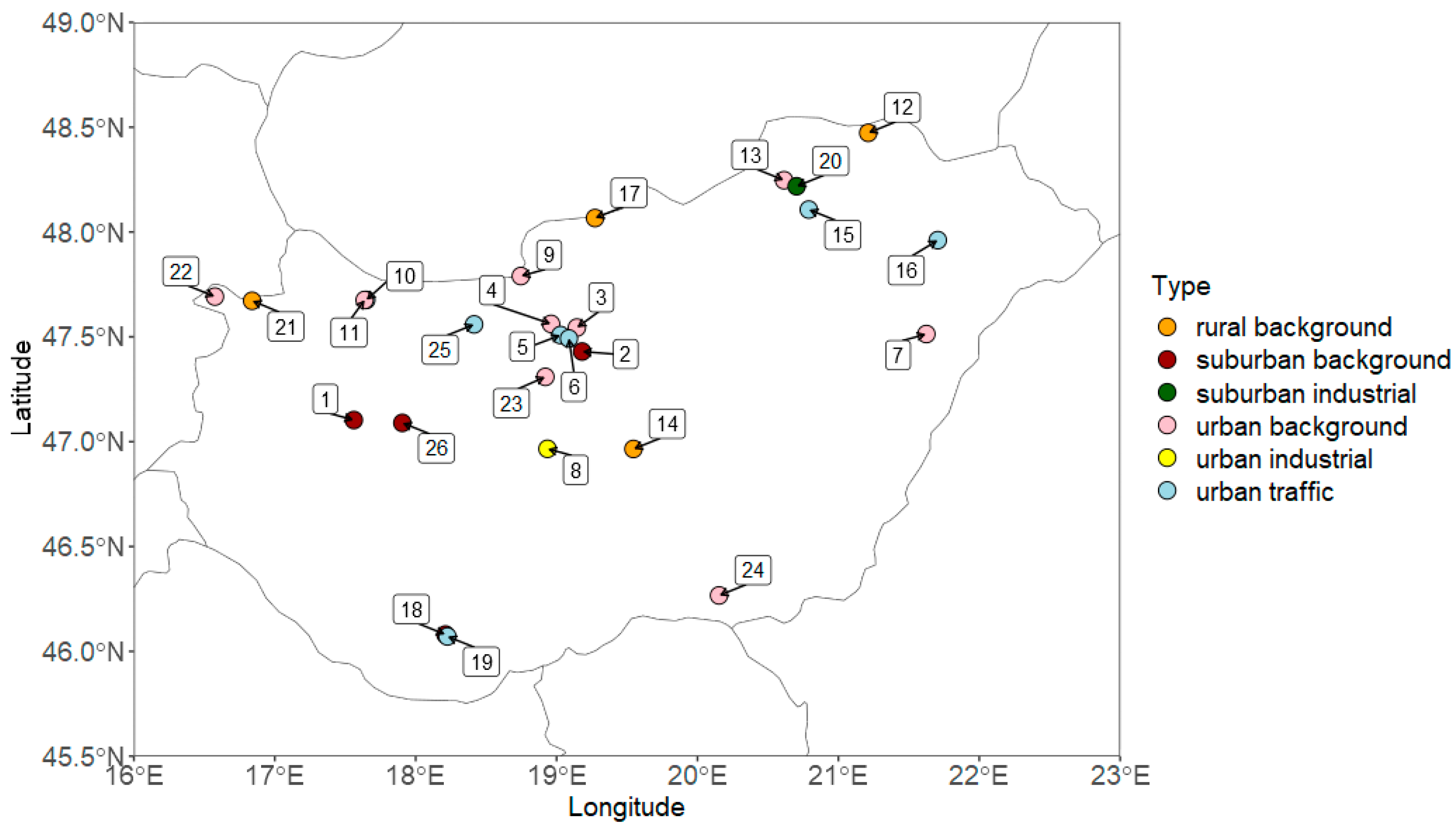
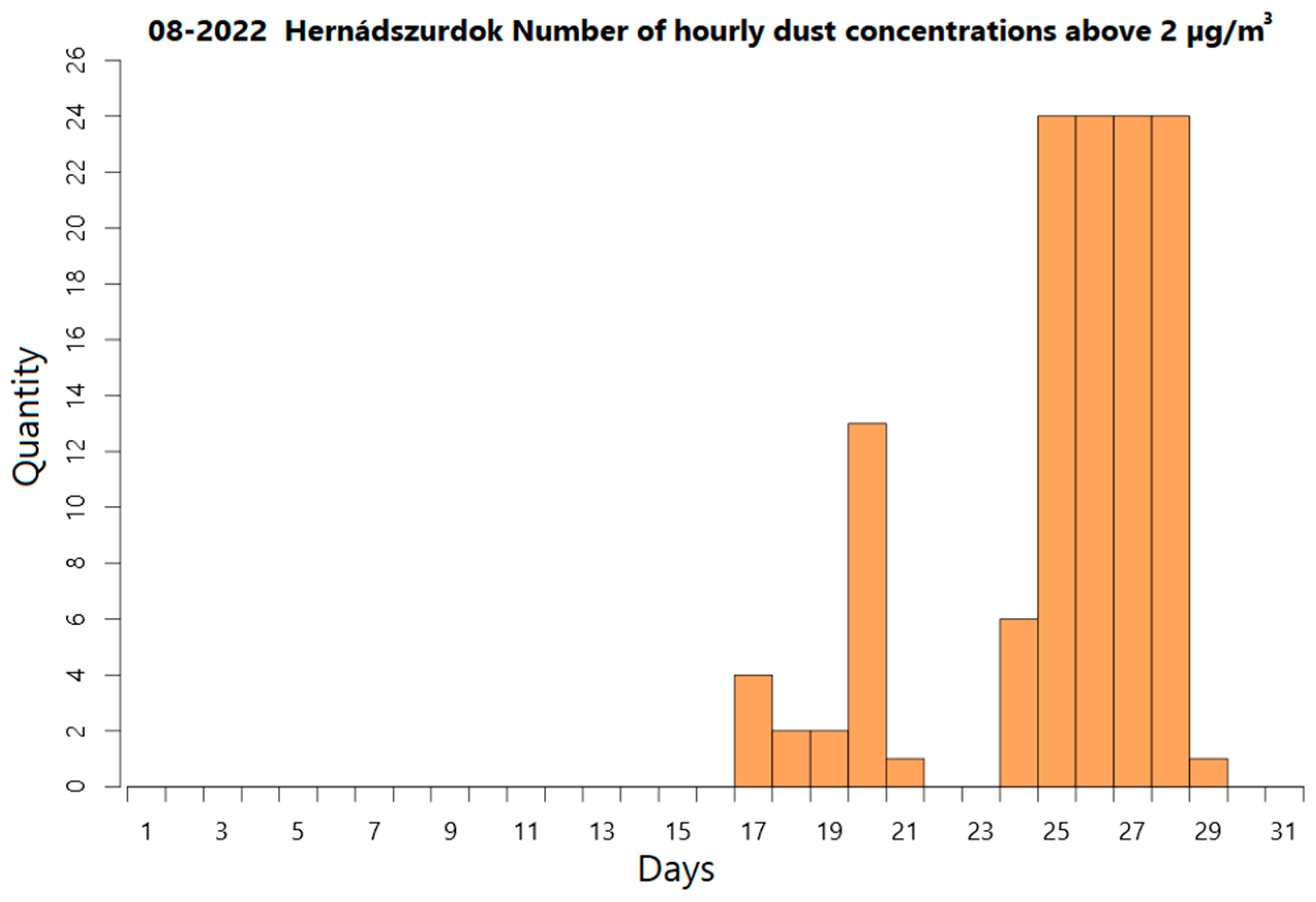
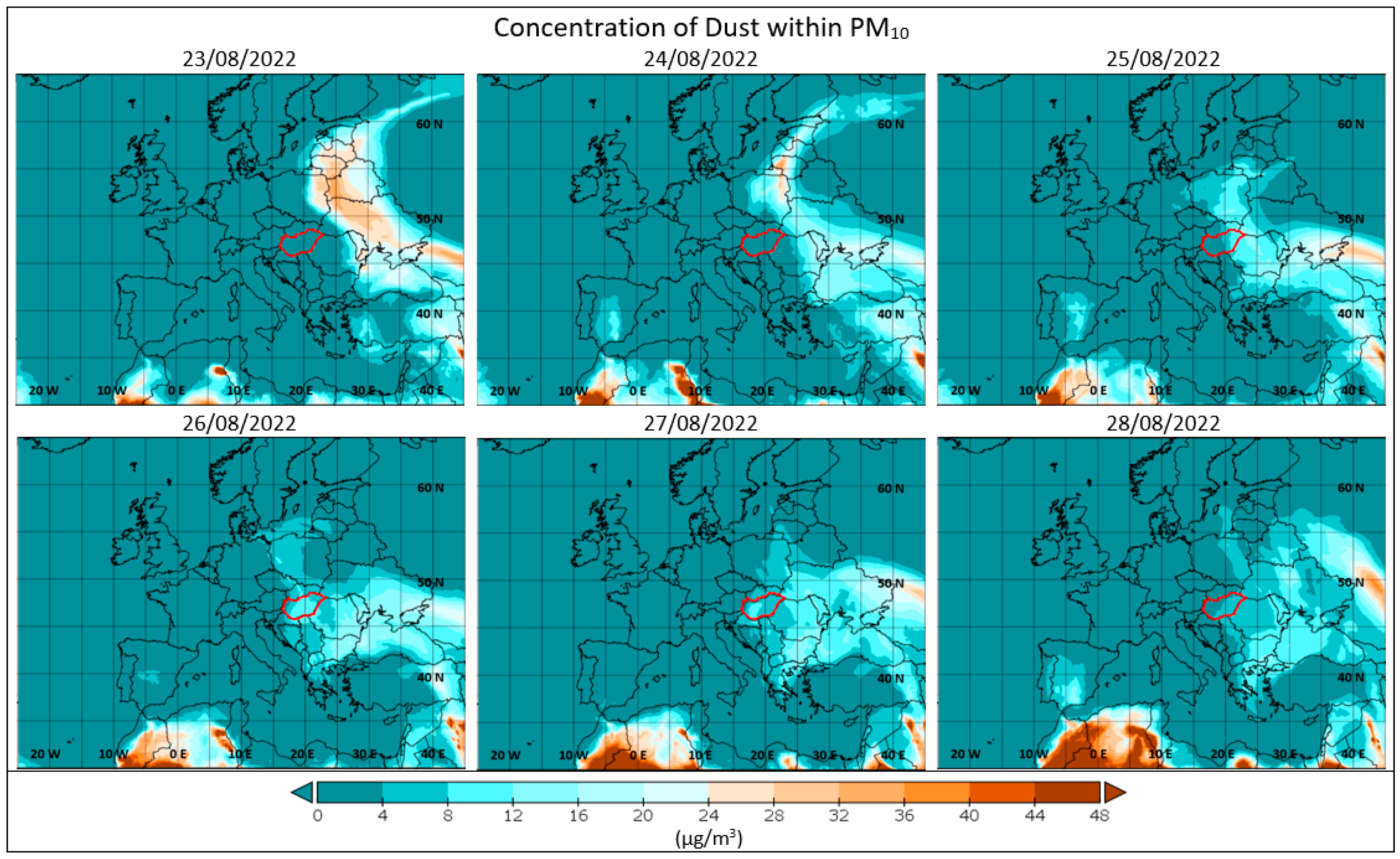
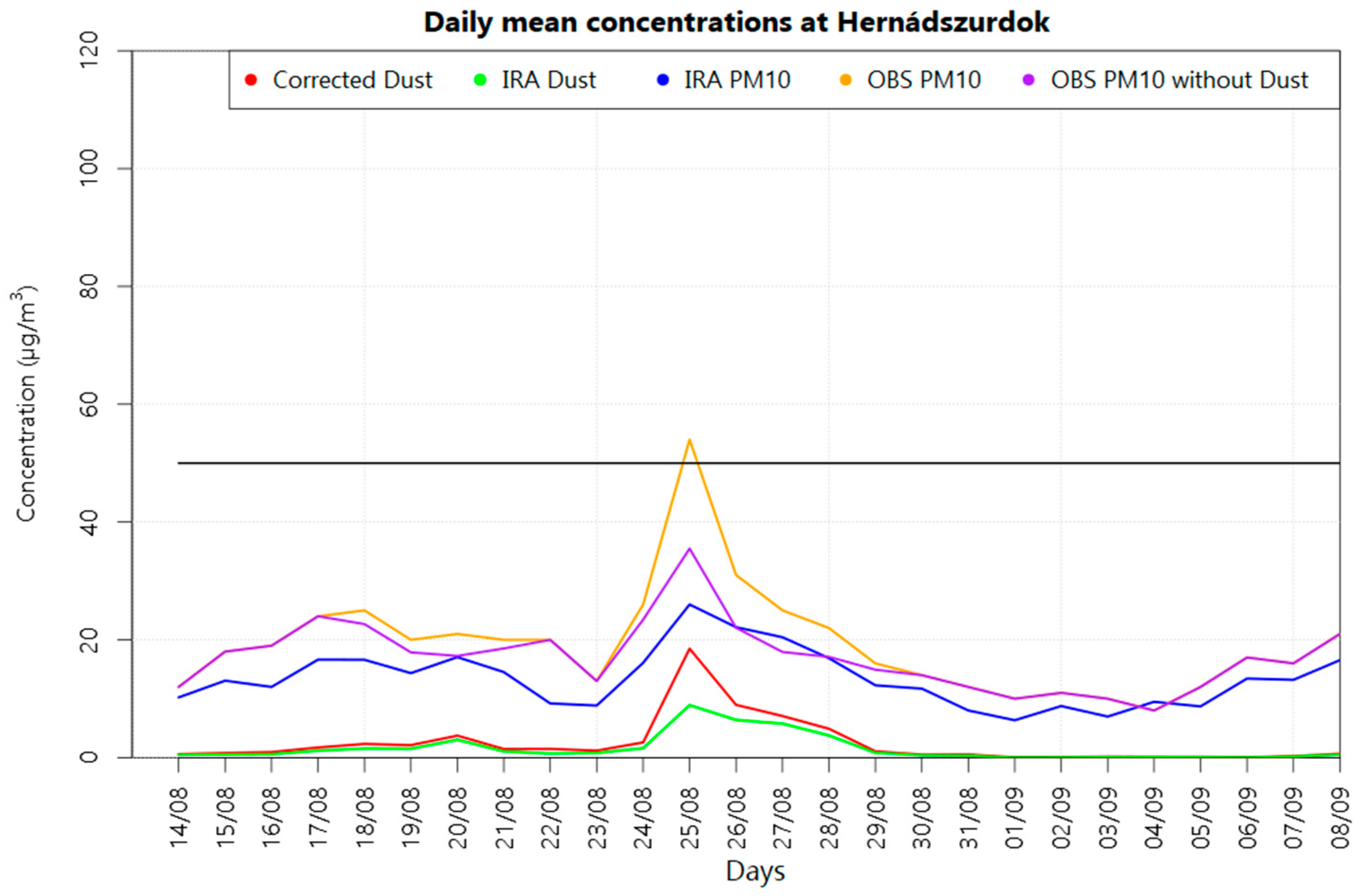
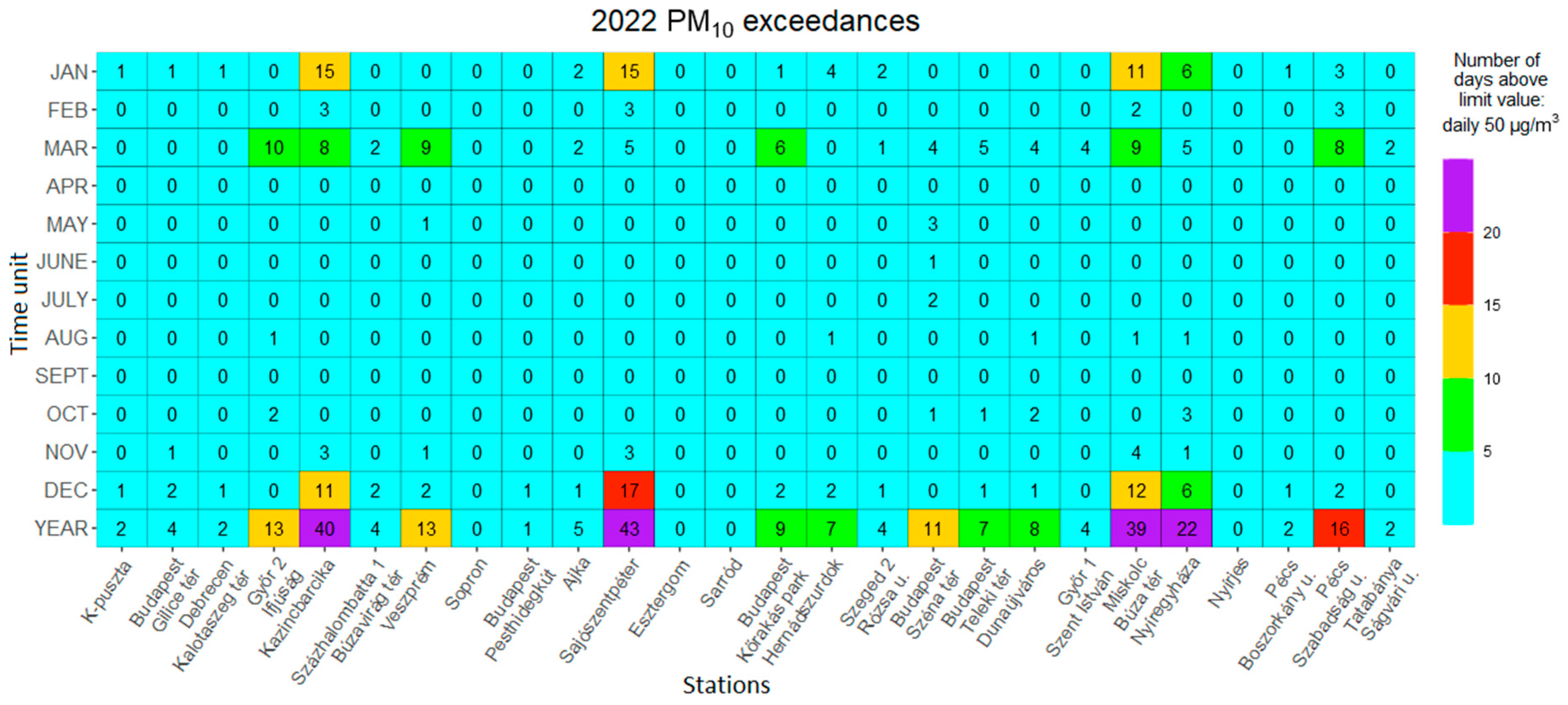
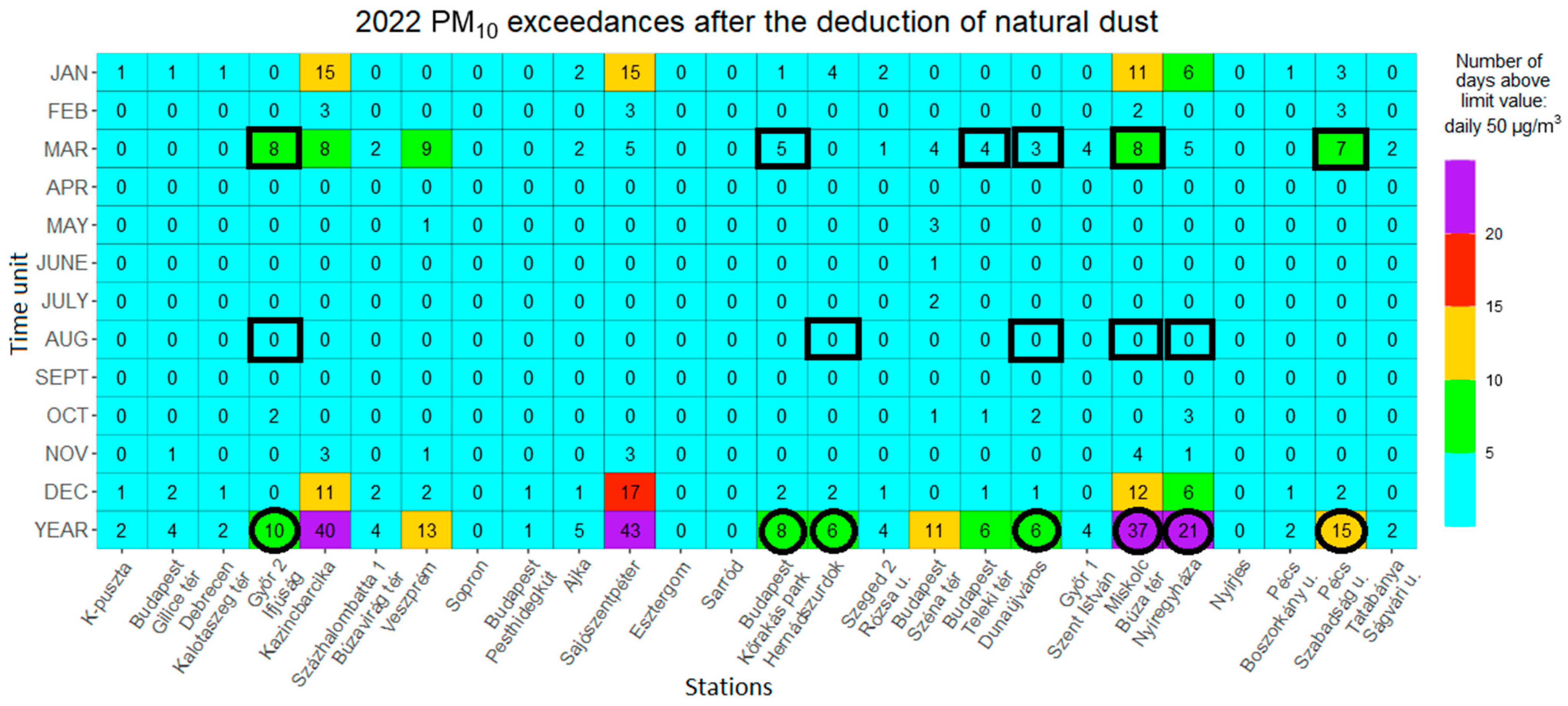
| Values in µg/m3 | MAR | JUNE | JULY | AUG | OCT | NOV |
|---|---|---|---|---|---|---|
| Ajka | −0.71 | −0.58 | −0.40 | −1.51 | −1.84 | −0.76 |
| Budapest Gilice | −0.70 | −0.64 | −0.80 | −1.77 | −0.02 | – |
| Budapest Kőrakás park | −0.89 | −0.63 | −0.67 | −1.33 | −1.70 | −0.66 |
| Budapest Pesthidegkút | −0.71 | −0.62 | −0.67 | −1.43 | −1.14 | −0.59 |
| Budapest Széna tér | −0.96 | −0.18 | −0.96 | −1.15 | −1.39 | −0.53 |
| Budapest Teleki tér | −0.88 | −0.86 | −0.87 | −1.41 | −1.36 | −0.61 |
| Debrecen Kalotaszeg | −0.65 | −0.38 | −0.79 | −1.92 | −0.85 | −1.03 |
| Dunaújváros | −0.83 | −0.79 | −0.88 | −2.32 | −1.92 | −0.96 |
| Esztergom | −0.59 | −0.40 | −0.36 | −1.50 | −0.95 | −0.40 |
| Győr 1 Szent István | −0.73 | – | −0.58 | – | −1.38 | −0.63 |
| Győr 2 Ifjúság | −0.72 | −0.51 | −0.42 | −1.86 | −0.92 | – |
| Hernádszurdok | −0.51 | −0.29 | −0.59 | −1.70 | −0.66 | −0.79 |
| Kazincbarcika | −0.74 | −0.36 | −0.73 | −2.24 | −1.02 | −1.08 |
| K-puszta | −0.76 | −0.56 | −0.69 | −1.63 | −1.48 | −0.92 |
| Miskolc Búza tér | −0.85 | −0.52 | −0.99 | −2.00 | −1.12 | −0.99 |
| Nyíregyháza | −0.92 | −0.42 | −0.98 | −2.58 | −1.13 | −1.21 |
| Nyírjes | −0.76 | −0.30 | −0.41 | −1.11 | −0.63 | −0.45 |
| Pécs Boszorkány u. | −0.70 | −0.89 | −0.80 | −2.48 | −1.60 | −0.90 |
| Pécs Szabadság u. | −0.93 | −1.16 | −0.71 | −1.61 | −1.63 | −1.04 |
| Sajószentpéter | −0.64 | −0.46 | −0.82 | −1.40 | −1.28 | −1.07 |
| Sarród | −2.43 | −0.45 | −0.13 | −1.09 | −1.16 | −0.40 |
| Sopron | −0.61 | – | – | −1.08 | −1.00 | – |
| Százhalombatta | −0.71 | −0.29 | −0.66 | −1.46 | −1.66 | −0.74 |
| Szeged 2 Rózsa u. | −0.51 | −0.76 | −0.96 | −2.14 | −1.12 | −0.39 |
| Tatabánya Ságvári u. | −0.62 | −0.44 | −0.33 | – | −1.38 | −0.58 |
| Veszprém | −0.70 | −0.54 | −0.39 | −1.99 | −1.00 | −0.31 |
Disclaimer/Publisher’s Note: The statements, opinions and data contained in all publications are solely those of the individual author(s) and contributor(s) and not of MDPI and/or the editor(s). MDPI and/or the editor(s) disclaim responsibility for any injury to people or property resulting from any ideas, methods, instructions or products referred to in the content. |
© 2024 by the authors. Licensee MDPI, Basel, Switzerland. This article is an open access article distributed under the terms and conditions of the Creative Commons Attribution (CC BY) license (https://creativecommons.org/licenses/by/4.0/).
Share and Cite
Tóth, A.; Ferenczi, Z. Saharan Dust Contributions to PM10 Levels in Hungary. Air 2024, 2, 325-336. https://doi.org/10.3390/air2030019
Tóth A, Ferenczi Z. Saharan Dust Contributions to PM10 Levels in Hungary. Air. 2024; 2(3):325-336. https://doi.org/10.3390/air2030019
Chicago/Turabian StyleTóth, Anita, and Zita Ferenczi. 2024. "Saharan Dust Contributions to PM10 Levels in Hungary" Air 2, no. 3: 325-336. https://doi.org/10.3390/air2030019
APA StyleTóth, A., & Ferenczi, Z. (2024). Saharan Dust Contributions to PM10 Levels in Hungary. Air, 2(3), 325-336. https://doi.org/10.3390/air2030019







